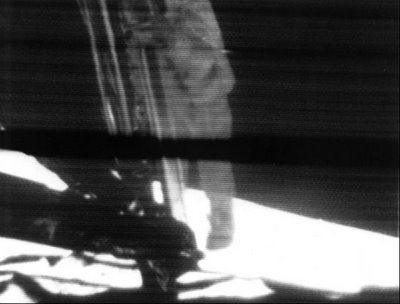 Neil Armstrong takes first step on the Moon. Polaroid image of slow scan television footage on Goldstone Station
Neil Armstrong takes first step on the Moon. Polaroid image of slow scan television footage on Goldstone StationThe heart-stopping moments when Neil Armstrong took his first tentative steps onto another world are defining images of the 20th century: grainy, fuzzy, unforgettable.
At 2:56 UTC on July 21, six and a half hours after landing, Armstrong made his descent to the Moon surface and spoke his famous line "That's one small step for (a) man, one giant leap for mankind".
But just 37 years after Apollo 11, it is feared the magnetic tapes that recorded the first moon walk - beamed to the world via three tracking stations, - have gone missing at NASA's Goddard Space Centre in Maryland.
A desperate search has begun amid concerns the tapes will disintegrate to dust before they can be found.
It is not widely known that the Apollo 11 television broadcast from the moon was a high-quality transmission, far sharper than the blurry version relayed instantly to the world on that July day in 1969.
Also among tapes feared missing are the original recordings of the other five Apollo moon landings. The format used by the original pictures beamed from the moon was not compatible with commercial technology used by television networks. So the images received at Parkes, and at tracking stations near Canberra and in California, were played on screens mounted in front of conventional television cameras.
"The quality of what you saw on TV at home was substantially degraded" in the process, Mr Sarkissian said, creating the ghostly images of Armstrong and Aldrin that strained the eyes of hundreds of millions of people watching around the world.
more
via
No comments:
Post a Comment